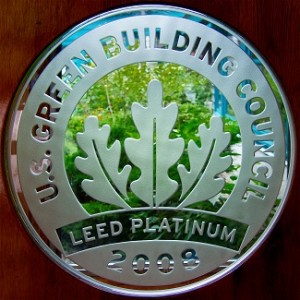 In the United States, there are more than 5 million commercial and industrial buildings, and combined they are responsible for 45 percent of the total amount of greenhouse gasses that are generated in this country. Furthermore, the EPA reports that 30 percent of the energy consumed by these buildings is used inefficiently or unnecessarily.
In the United States, there are more than 5 million commercial and industrial buildings, and combined they are responsible for 45 percent of the total amount of greenhouse gasses that are generated in this country. Furthermore, the EPA reports that 30 percent of the energy consumed by these buildings is used inefficiently or unnecessarily.
Thankfully, there are several entities that support and reward energy efficiency, responsible water use, healthy indoor air quality, and use of eco-friendly materials. One of the most recognized organizations driving green buildings is the U.S. Green Building Council and it’s LEED program, which has registered and certified 47,134 building projects worldwide. LEED certifications are obtained through a points-based evaluation in several building categories. One of those categories is water efficiency, which is of course, where flow meters come in.
LEED Certifiable Water Efficiency
Within the LEED rating system for Existing Buildings Operations and Maintenance, 14 points are available for water efficiency, two of which hinge on “water performance measurement.” The purpose of this category is to evaluate building and subsystem water use over time, discover consumption patterns, and identify opportunities to save water. Sound familiar? Let’s go over how flow meters can help you earn these points.
Whole Building Metering (1 point)
Permanently installed water meters must be put in place that will measure the building’s total potable water use. The meter data should be collected regularly and compiled into summaries on a monthly and annual basis. You are also encouraged to measure grey or reclaimed water use.
** It’s important to note that the most water-efficient systems and subsystems run with very low flow rates— sometimes down to just a trickle— especially if we’re talking about indoor plumbing. While this is great for cutting consumption, most meters are incapable of providing accurate measurements at these reduced flow rates, or any measurement at all. For this reason, it is imperative that green buildings employ flow meters with the greatest turndown capabilities, such as a Cadillac® Magnetic flow meter.**
Submetering (2 points)
In addition to meeting the above requirements, a building must have permanently installed metering in place for one or more of the following subsystems:
-
Irrigation. Install a flow meter for water systems that serve 80% or more of the irrigated landscape area on the grounds (excluding synthetic landscapes and native vegetation that requires no routine irrigation).
-
Indoor plumbing fixtures and fittings. Install a flow meter for water systems that serve 80% or more of indoor plumbing fixtures and fittings, such as toilets, urinals, faucets, and showerheads.
-
Cooling towers. Install a flow meter to measure the water consumption of all cooling towers serving the building.
-
Domestic hot water. Install a flow meter to measure the water use of 80% or more of the domestic hot water heating capacity, including tanks and on-demand heaters.
-
Other process water. Install a flow meter to measure 80% or more of daily water consumption for end uses, such as humidification systems, dishwashers, pools and other systems that use process water.
As with whole building metering, the analysis of time and trends for submetering depends on uninterrupted, data collection, and periodic result summaries must be compiled for each subsystem that is metered. Potable water consumption must be measured, however grey or reclaimed water use may also be measured to earn this credit.
If you are interested in a LEED certification for your building and you’re looking for the industry’s best metering devices, you’ve come to the right place. Call or email Cadillac Meter today and we’ll find the best measurement device for water efficiency project.